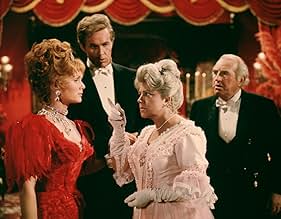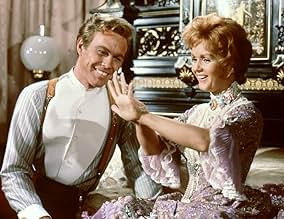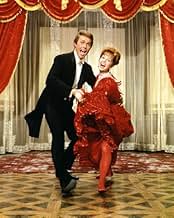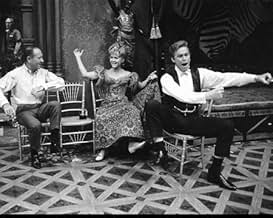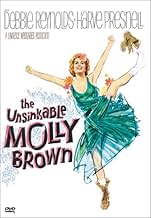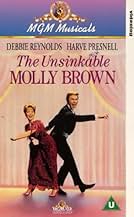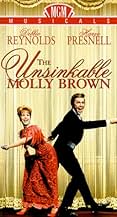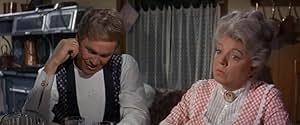Voglio essere amata in un letto d'ottone
Titolo originale: The Unsinkable Molly Brown
VALUTAZIONE IMDb
6,6/10
4489
LA TUA VALUTAZIONE
Aggiungi una trama nella tua linguaA poor, uneducated mountain girl leaves her cabin in search of respect, a wealthy husband, and a better life in this fictionalized biopic of Margaret "Molly" Brown, who survived the 1912 sin... Leggi tuttoA poor, uneducated mountain girl leaves her cabin in search of respect, a wealthy husband, and a better life in this fictionalized biopic of Margaret "Molly" Brown, who survived the 1912 sinking of the RMS Titanic.A poor, uneducated mountain girl leaves her cabin in search of respect, a wealthy husband, and a better life in this fictionalized biopic of Margaret "Molly" Brown, who survived the 1912 sinking of the RMS Titanic.
- Regia
- Sceneggiatura
- Star
- Candidato a 6 Oscar
- 5 vittorie e 13 candidature totali
Recensioni in evidenza
I don't know what it was, but I couldn't really get into this movie, be affected by it or enjoy it very much. Well, yeah, the society party scenes were a hoot, the scenery was pretty, the chereography of the "Friend" song was good, but that was about it. The rest was just... there, not horrible, but definitly not above average, either.
Debbie Reynolds should have been very well suited to the role of Molly Brown, but for all her teeth-gritting, yelling, and wailing, she just doesn't rise to the occasion. Why this is often considered her best role, and why she was nominated for an Oscar for it, I really couldn't tell you. Harve Presnell has a soaring voice, but again, just is average. The Merideth Willson score is rather pedestrian. (Apparently several songs were cut from the Broadway show; maybe they were better.) But really, this guy did The Music Man? And the Titanic sinking is done and dispensed with in maybe two minutes, if that. Come on! The one reason this musical was made was because of Mrs. Brown's legendary courage after that sinking. Not much evidence of that here. Oh, and yes, the musical is pretty accurate in terms of the many legends surrouding Margaret Brown, but not so faithful to the real person. (Many minute things: she was never rescued from a flood as a baby, she was actually born and raised in Hannibal, Missouri, her husband was always called J.J., never Johnny, they never really did reconcile, she actually had two children with him that were not mentioned, she never really was accepted by the Sacred Thirty-Six, her many contributions to the juvenile and suffrage movements were ignored as always, etc. and so forth. She was never even called Molly, always Margaret.) You get the point...
It simply wasn't anything special.
Debbie Reynolds should have been very well suited to the role of Molly Brown, but for all her teeth-gritting, yelling, and wailing, she just doesn't rise to the occasion. Why this is often considered her best role, and why she was nominated for an Oscar for it, I really couldn't tell you. Harve Presnell has a soaring voice, but again, just is average. The Merideth Willson score is rather pedestrian. (Apparently several songs were cut from the Broadway show; maybe they were better.) But really, this guy did The Music Man? And the Titanic sinking is done and dispensed with in maybe two minutes, if that. Come on! The one reason this musical was made was because of Mrs. Brown's legendary courage after that sinking. Not much evidence of that here. Oh, and yes, the musical is pretty accurate in terms of the many legends surrouding Margaret Brown, but not so faithful to the real person. (Many minute things: she was never rescued from a flood as a baby, she was actually born and raised in Hannibal, Missouri, her husband was always called J.J., never Johnny, they never really did reconcile, she actually had two children with him that were not mentioned, she never really was accepted by the Sacred Thirty-Six, her many contributions to the juvenile and suffrage movements were ignored as always, etc. and so forth. She was never even called Molly, always Margaret.) You get the point...
It simply wasn't anything special.
This is not a review, but an inquiry. Does anyone know who the real-life baby was that portrayed Molly as a baby in the beginning of the movie going over the rapids in a cradle? I saw a very old "filler" once on TCM which featured swim instruction for very young children, some as young as 12 months. The instructor had them swimming to the pool bottom to retrieve items as well as racing each other to see who reached the other side first. I believe early swim instruction had gained some measure of popularity in California during the 30s. Most of the footage of the rapids was of a dummy. Other footage was of the baby in a water tank on a sound stage with footage of rapids being shown in the background. The final few seconds of that scene show the cradle overturning very close to shore and spilling the baby out. The baby then swims to shore and crawls out - that part is real. I sure would like to know who that baby was. It was precious!
I used to watch this movie when I was little, and I just recently rediscovered it. It's amazing how much better movies can get once you grow up. Debbie Reynolds portrays Molly Brown wonderfully. Her singing and dancing alone make this movie worth watching. My favorite scene is the "He's my friend, and he'll stay my friend...." scene. If you haven't seen this movie, you should definitely watch it. It's so great!
One of my favorite shows with plenty of singin' and dancin' all the way from the simple countryside, to the big city, and over to the even bigger city life of Europe. Debbie plays a tomboy country girl who can't wait to leave the outback and live the high life in Denver. On the way to this better life she crosses paths with a prospector who changes her life and not always for her betterment as far as she is concerned. She finds that her dreams of wealth and a place in high society are not necessarily what will make her happy in the real world. This is a very delightful film with lots of beautiful scenery, props, and great performances by the entire cast.
6B24
I had the pleasure of accompanying my great aunt and one of her contemporaries to the opening of this movie in Denver in 1964. Because they had known the old girl herself (the real Mrs. Margaret Brown, that is) back in the early years of the century, both in Leadville and Denver, they were keen on seeing what Hollywood and Debbie had done with the story.
I remember vividly watching their reactions turn from initial pleasure with the opening number to puzzlement when Debbie started to chew the scenery and behave like, well, Debbie Reynolds. This was followed by Ed Begley and the boys in the saloon hooting it up, and the two old ladies next to me started to frown a bit and whisper something to the effect that "it was not like that at all." They were becoming quite restless until the Denver bits began, but they seemed to accept the remainder of the story with a good deal of resignation that it was all just good fun and nonsense, and wasn't that what going to the movies was all about?
Afterward, as we strolled over to the Brown Palace for dinner, they regaled me with a complete history of the real Mrs. Brown and the many mutual friends they had enjoyed meeting at that same venue from roughly 1895 to 1915 when they were themselves just being presented into Denver society. I learned, among other things, that Mrs. Brown was considered an eccentric but generally well-liked and articulate woman who, despite never really being accepted at the toniest levels, became a legend in her own time after the Titanic episode. That part of the story was not only true, but actually a larger-than-life experience, the details of which they agreed should have been featured more profoundly in the film version.
The next time I drove down Wadsworth Blvd. and saw Mrs. Brown's "Summer House," a rather grand Victorian edifice like the better known one in the center of Denver, I tried to picture Debbie Reynolds in that setting and could not quite fit the two together. That in spite of the fact that Debbie herself grew up in El Paso at the southern end of the same Rocky Mountains that rise northward through Colorado.
I remember vividly watching their reactions turn from initial pleasure with the opening number to puzzlement when Debbie started to chew the scenery and behave like, well, Debbie Reynolds. This was followed by Ed Begley and the boys in the saloon hooting it up, and the two old ladies next to me started to frown a bit and whisper something to the effect that "it was not like that at all." They were becoming quite restless until the Denver bits began, but they seemed to accept the remainder of the story with a good deal of resignation that it was all just good fun and nonsense, and wasn't that what going to the movies was all about?
Afterward, as we strolled over to the Brown Palace for dinner, they regaled me with a complete history of the real Mrs. Brown and the many mutual friends they had enjoyed meeting at that same venue from roughly 1895 to 1915 when they were themselves just being presented into Denver society. I learned, among other things, that Mrs. Brown was considered an eccentric but generally well-liked and articulate woman who, despite never really being accepted at the toniest levels, became a legend in her own time after the Titanic episode. That part of the story was not only true, but actually a larger-than-life experience, the details of which they agreed should have been featured more profoundly in the film version.
The next time I drove down Wadsworth Blvd. and saw Mrs. Brown's "Summer House," a rather grand Victorian edifice like the better known one in the center of Denver, I tried to picture Debbie Reynolds in that setting and could not quite fit the two together. That in spite of the fact that Debbie herself grew up in El Paso at the southern end of the same Rocky Mountains that rise northward through Colorado.
Lo sapevi?
- QuizAs with most Hollywood biopics, there are liberties taken with the real story, most notably in that Margaret (Molly) and J.J. never reconciled. They separated in 1909, although they remained good friends who cared deeply for each other until his passing. She was also not quite the social outcast depicted in the film. Other aspects of her life that were missing from the movie: they had two children, a son and daughter. Margaret Brown was a passionate social crusader and philanthropist; she was a champion of women's rights, including education and the vote. She championed workers' rights, historic preservation, education and literacy, and child welfare, including helping to found the modern juvenile court system. After the sinking of the Titanic, she was noted for her efforts to commemorate the heroism of the men aboard the ship. After WWI, she helped to rebuild France and to aid wounded soldiers, and received the French Legion of Honor. She also ran twice for the U.S. Senate. She died in 1932.
- BlooperWhen Molly first meets John, in the 1880s, they look at some picture postcards she has with her. The picture occupies one entire side of each card, but postcards of this type were not available in the USA until 1907.
- Citazioni
Molly Brown: Nobody wants to see me down like I wants to see me up.
- Curiosità sui creditiintroducing Harve Presnell
- Versioni alternativeIn the past, TCM has shown a version with Overture and Exit Music that ran 135 minutes. It also had a slightly different aspect ratio.
- ConnessioniEdited from Titanic (1953)
- Colonne sonoreOverture (Belly Up to the Bar, Boys/I Ain't Down Yet/I'll Never Say No/Colorado, My Home)
(uncredited)
Music and Lyrics by Meredith Willson
Performed by Robert Armbruster and The MGM Symphony Orchestra (as the MGM Studio Orchestra)
I più visti
Accedi per valutare e creare un elenco di titoli salvati per ottenere consigli personalizzati
Dettagli
Botteghino
- Lordo Stati Uniti e Canada
- 13.167.200 USD
- Tempo di esecuzione
- 2h 8min(128 min)
- Colore
- Proporzioni
- 2.35 : 1
Contribuisci a questa pagina
Suggerisci una modifica o aggiungi i contenuti mancanti


